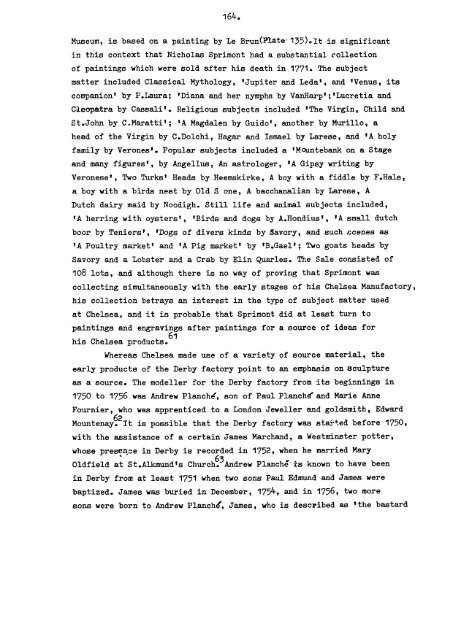HUGIJENOT ARTISTS DESIGNERS AND CRAYPSNEN IN GREAT ...
HUGIJENOT ARTISTS DESIGNERS AND CRAYPSNEN IN GREAT ...
HUGIJENOT ARTISTS DESIGNERS AND CRAYPSNEN IN GREAT ...
You also want an ePaper? Increase the reach of your titles
YUMPU automatically turns print PDFs into web optimized ePapers that Google loves.
16k.<br />
Museum, is based on a painting by Le Brun(P1&te 135).It is significant<br />
in this context that Nicholas Sprimont had a substantial collection<br />
of paintings which were sold after his death in 1771. The subject<br />
matter included Classical Mythology, 'Jupiter and Leda', and 'Venus, its<br />
companion' by P.Laura; 'Diana and her nymphs by Vanflarp';'Lucretia arid<br />
CLeopatra by Ca.ssali'. Religious subjects included 'The Virgin, Child and<br />
St.John by C.Maratti'; 'A Magdalen by Guido', another by Murillo, a<br />
head of the Virgin by C.Dolchi, Hagar and Ismael by Larese, and 'A holy<br />
family by Verones'. Popular subjects included a 'Mountebank on a Stage<br />
and many figures', by Angellus, An astrologer, 'A Gipsy writing by<br />
Veronese', Two Turks' Heads by Heemskirke, A boy with a fiddle by F.Hals,<br />
a boy with a birds nest by Old S one, A bacchanalian by Larese, A<br />
Dutch dairy maid by Noodigh. Still life and animal subjects included,<br />
'A herring with oysters', 'Birds and dogs by A.Hondius', 'A small dutch<br />
boor by Teniers', 'Dogs of divers kinds by Savory, and such scenes as<br />
'A Poultry market' and 'A Pig market' by 'B.Gael'; Two goats heads by<br />
Savory and a Lobster and a Crab by Elm Quarles. The Sale consisted of<br />
108 lots, and although there is no way of proving that Sprimont was<br />
collecting simultaneously with the early stages of his Chelsea Manufactory,<br />
his collection betrays an interest in the type of subject matter used<br />
at Chelsea, and it is probable that Sprimont did at least turn to<br />
paintings and engravings after paintings for a source of ideas for<br />
61<br />
his Chelsea products.<br />
Whereas Chelsea made use of a variety of source material, the<br />
early products of the Derby factory point to an emphasis on sculpture<br />
as a source. The modeller for the Derby factory from its beginnings in<br />
1750 to 1756 was Andrew Planch, son of Paul Planch and Marie Anne<br />
Fournier, who was apprenticed to a London Jeweller and goldsmith, Edward<br />
Mountenay 2 It is possible that the Derby factory was staited before 1750,<br />
with the assistance of a certain James Marchand, a Westminster potter,<br />
whose presene in Derby is recorded in 1752, when he married Mary<br />
Oldfield at St.Alkmund's Church.3Andrew Planchis known to have been<br />
in Derby from at least 1751 when two sons Paul Edmund and James were<br />
baptized. James was buried in December, 175k, and in 1756, two more<br />
sons were born to Andrew Planchl, James, who is described as<br />
bastard
















